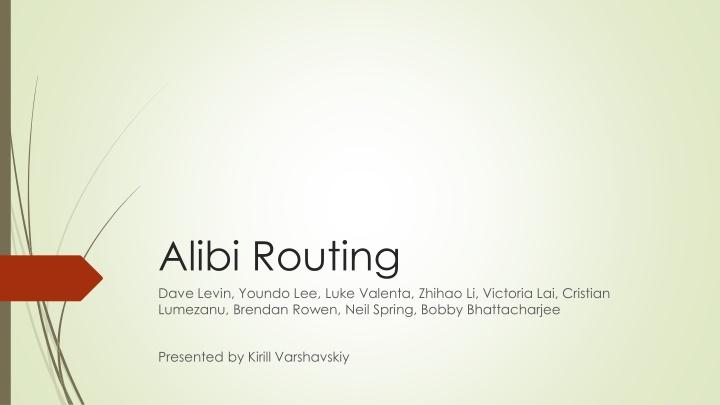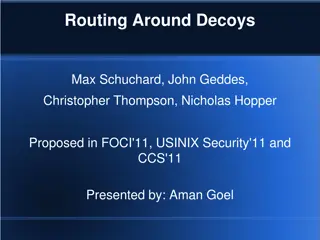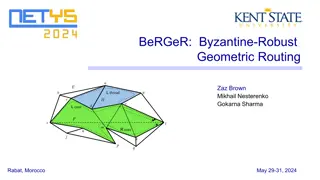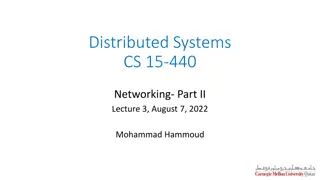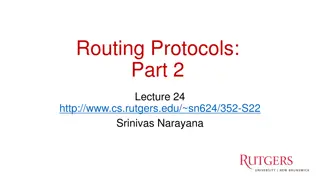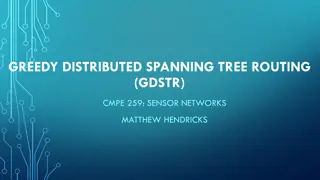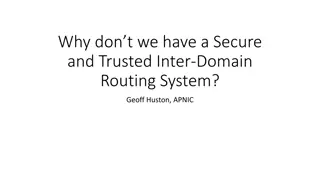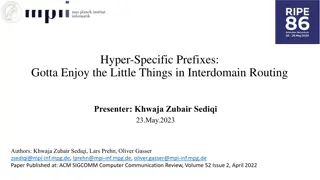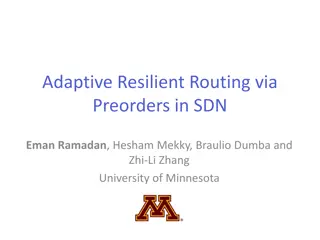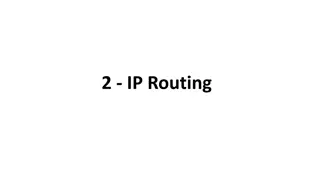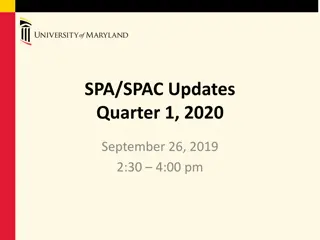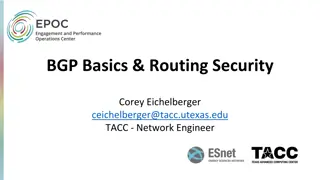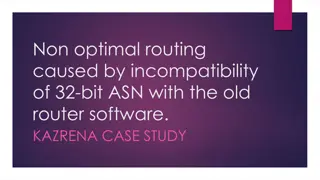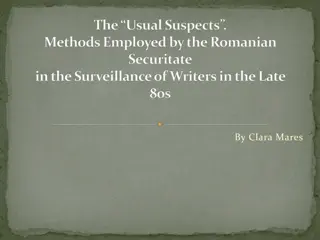Alibi Routing and Internet Surveillance
Alibi routing provides a unique approach to data routing, ensuring packets avoid forbidden regions. Explore how this system safeguards communication integrity and the challenges it addresses in the face of censorship and monitoring.
Download Presentation

Please find below an Image/Link to download the presentation.
The content on the website is provided AS IS for your information and personal use only. It may not be sold, licensed, or shared on other websites without obtaining consent from the author.If you encounter any issues during the download, it is possible that the publisher has removed the file from their server.
You are allowed to download the files provided on this website for personal or commercial use, subject to the condition that they are used lawfully. All files are the property of their respective owners.
The content on the website is provided AS IS for your information and personal use only. It may not be sold, licensed, or shared on other websites without obtaining consent from the author.
E N D
Presentation Transcript
Alibi Routing Dave Levin, Youndo Lee, Luke Valenta, Zhihao Li, Victoria Lai, Cristian Lumezanu, Brendan Rowen, Neil Spring, Bobby Bhattacharjee Presented by Kirill Varshavskiy
Sniff sniff State agencies censor and log citizens internet traffic Abundant in certain regions China Syria North Korea Saudi Arabia Bahrain Iran Vietnam
Censor-avoidance Censorship and Surveillance Dropping packets Injecting data into packets Logging packets Routing protocols often don t consider intermediate nodes Traffic can route through geographic region which might inject data into packet Data integrity Nations may log routing info + drop packets
Past Approaches BGP Poisoning (avoidance) Failure prone regions blacklisted in BGP Tor (other overlay systems) Anonymized internet usage May pass through censored region when going between hops Geographical routing Greedy routing, no avoidance Some systems provide means to monitor regions visited, but no insurance/proof that certain places were not visited
What Alibi routing is and what it isnt Provides Overlay P2P network for data routing Proof that sent packet did not enter forbidden region after packet has completed its RTT Proof per packet as routing can traverse various paths due to packet switching/routing decisions Does not Provide Guarantee that data is not delivered to forbidden region Malicious nodes not in forbidden region might copy and send it elsewhere Assurance of reliable communication, just a proof that it didn t enter the region AFTER transmission
Terminology and definitions Forbidden Region Geographical location that should not be entered Represented by a list of <lat, long> coordinates depicting a geo-polygon Alibi Relay that can be safely used to divert traffic around forbidden region Picked such that passing through Alibi AND forbidden region will cause noticeable delay increase Target regions Regions in which Alibis might reside Aid in locating Alibi (delta) Coefficient to ensure safety under latency fluctuations Used to determine target regions
Proof of avoidance Proving something did not happen is difficult Proving something related cannot possibly happen is less difficult How do you prove packet did not go through forbidden region? Consider event x depicting a situation in which a packet traverses through a forbidden region Consider event A depicting a situation where a packet does not traverse through a forbidden region A and x are mutually exclusive Showing x is impossible, authors show A is true
Assumptions All non-forbidden nodes are trustworthy Nodes cannot lie about smaller RTTs Based on various signing schemes, returned packet will show all (trustworthy) nodes it traversed
Relay Guarantees Given path s -> r -> d with an RTT rtt_time d T Calculate RTT through s, r, and d AND the closest possible f to be rtt_forbidden If rtt_time is a factor of delta smaller than rtt_forbidden, initial path could not have possibly traversed f r f f F s
Targeting the target region Alibi Routing consists of an overlay network of P2P nodes, each with coarse GPS coords d Target region contains Alibi node T Authors partition world into grid of points For each point, consider it as g, calculate threshold f All calculations based on greater-circle distance f F g 1 + ? ???????? ??? 3 s ? ? ??????????????(?,?)
Alibi, where art thou? d T Each node keeps an active peer list and a neighbor list Occasionally sends out random nonces to get neighbors GPS coords f Ping responses come with correct RTT as nonce is random and thus response cannot be pre- constructed f F Each hop from source tries to minimize distance to target region s
Security Concerns Time/distance calculations prevent underselling of RTT from malicious nodes Eclipse attack: surround node with all malicious nodes Requires attack nodes to be physically close to trustworthy nodes Algorithm should route hops away from forbidden regions Sending data copies to attackers End to end encryption can solve this, otherwise, nothing would effectively prevent this Laundering traffic: using relays to attack hosts Similar approach as to other systems, whitelisting, solutions exist
Evaluation Authors simulated deployment of 20,000 nodes and PlanetLab simulation of 245 hosts Enemies of the Internet labeled as forbidden regions + countries with most Internet users (USA, India, Japan) Most source-destination pairs successful
Evaluation Protocol success using simulation and PlanetLab deployment showed almost 100% success in most value cases Due to limited PlanetLab deployment, at most 2 hops were needed to find relay. Around 40 in simulation.
Conclusion and Comments Alibi routing can be used as an intelligent P2P network that bypasses unwanted territories in an efficient manner Current implementation has to be manually configured. Would be interesting to see how system works in a practical deployment with backoff techniques Does not tackle various downsides of the algorithm, for example being surrounded by forbidden region or having several forbidden regions, or failure cases where alibis incur too much of a latency to be effective Authors mention Alibi routing can be used in tandem with Tor, which should be very beneficial to both technologies P2P design requires lots of nodes to be online/active
References https://en.wikipedia.org/wiki/Internet_censorship http://conferences.sigcomm.org/sigcomm/2015/pdf/papers/p611.pdf http://alibi.cs.umd.edu/ https://firemon-firemon.netdna-ssl.com/wp- content/uploads/2014/11/firewall.lgo_.jpg http://archive.cone.informatik.uni- freiburg.de/people/ruehrup/georouting.png
Discussion Would you use Alibi routing for your Internet use? (show of hands) What other cases has Alibi routing not considered? How does this system handle Internet hubs? If hub for lots of the world s internet traffic is relayed through a forbidden region, how will the system adapt? Should this P2P network consider congestion of relay nodes as potential bottleneck?
